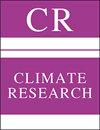首次产卵者对褐鳟种群增长的影响较小
IF 1.6
4区 地球科学
Q4 ENVIRONMENTAL SCIENCES
引用次数: 2
摘要
对于繁殖成功率存在个体差异的物种,育种经验和不同育种者的分布对种群生产力和生存能力至关重要。人类的影响,如气候变化和收获,可以改变这种分布,从而改变人口动态。本文研究了洄游褐鳟产卵经历对种群数量增长的影响,这些影响因素包括迁徙障碍、捕捞和气候变化。我们用一个结构化的整体投影模型来描述种群动态,该模型区分了首次产卵和重复产卵。然后,我们采用基于场景的方法,通过运行3种不同的模型模拟来测试产卵经验对褐鳟种群增长的积极影响程度:种群繁殖产量没有变化的基线情景,所有产卵者的繁殖产量减少的非选择性情景,以及只有首次产卵者的繁殖产量减少的选择性情景。我们发现重复产卵者的繁殖产出比首次产卵者的繁殖产出对种群增长更重要,这与其他研究一致。此外,首次产卵者通过自身生存对种群增长的贡献比通过繁殖对种群增长的贡献更重要。为了确保研究种群的持续存在,应优先考虑首次产卵者的生存和重复产卵者的繁殖成功。更一般地说,包括育种经验增加了更多的机械细节,最终有助于管理和保护工作。本文章由计算机程序翻译,如有差异,请以英文原文为准。
Low impact of first-time spawners on population growth in a brown trout population
For species with individual variation in reproductive success, experience in breeding and the distribution of different breeders is important for population productivity and viability. Human impacts, such as climate change and harvesting, can alter this distribution and thus population dynamics. Here, we investigated the effect of spawning experience on population growth in a population of migratory brown trout Salmo trutta subject to stressors including migration barriers, harvesting, and climate change. We described the population dynamics with a structured integral projection model that differentiates between first-time and repeat spawners. We then took a scenario-based approach to test to which extent spawning experience has a positive effect on the population growth of brown trout by running 3 different model simulations: a baseline scenario with no changes to the reproductive output of the population, a non-selective scenario in which the reproductive output of all spawners was reduced, and a selective scenario where the reproductive output of only first-time spawners was reduced. We found that the reproductive output of repeat spawners is more important than that of first-time spawners for population growth, in line with other studies. Moreover, the contribution of first-time spawners to the population growth through their own survival is more important than their contribution to growth through reproduction. To ensure the continued existence of the study population, survival of first-time spawners and reproductive success of repeat spawners should be prioritised. More generally, including breeding experience adds more mechanistic detail, which ultimately can aid management and conservation efforts.
求助全文
通过发布文献求助,成功后即可免费获取论文全文。
去求助
来源期刊

Climate Research
地学-环境科学
CiteScore
2.90
自引率
9.10%
发文量
25
审稿时长
3 months
期刊介绍:
Basic and applied research devoted to all aspects of climate – past, present and future. Investigation of the reciprocal influences between climate and organisms (including climate effects on individuals, populations, ecological communities and entire ecosystems), as well as between climate and human societies. CR invites high-quality Research Articles, Reviews, Notes and Comments/Reply Comments (see Clim Res 20:187), CR SPECIALS and Opinion Pieces. For details see the Guidelines for Authors. Papers may be concerned with:
-Interactions of climate with organisms, populations, ecosystems, and human societies
-Short- and long-term changes in climatic elements, such as humidity and precipitation, temperature, wind velocity and storms, radiation, carbon dioxide, trace gases, ozone, UV radiation
-Human reactions to climate change; health, morbidity and mortality; clothing and climate; indoor climate management
-Climate effects on biotic diversity. Paleoecology, species abundance and extinction, natural resources and water levels
-Historical case studies, including paleoecology and paleoclimatology
-Analysis of extreme climatic events, their physicochemical properties and their time–space dynamics. Climatic hazards
-Land-surface climatology. Soil degradation, deforestation, desertification
-Assessment and implementation of adaptations and response options
-Applications of climate models and modelled future climate scenarios. Methodology in model development and application
 求助内容:
求助内容: 应助结果提醒方式:
应助结果提醒方式:


